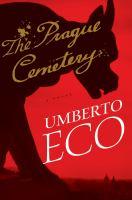
 Surprisingly, this book is not about Prague, or its famous cemetery; in fact only about 100 out of 460 pages cover anything remotely relating to Prague. The Prague Cemetery describes infamous hoaxes, forgeries and plagiarisms of the 19th century and how they fueled some of the most notable historical events that humanity would rather forget.
Surprisingly, this book is not about Prague, or its famous cemetery; in fact only about 100 out of 460 pages cover anything remotely relating to Prague. The Prague Cemetery describes infamous hoaxes, forgeries and plagiarisms of the 19th century and how they fueled some of the most notable historical events that humanity would rather forget.
Eco’s novel revolves mostly around the infamous, fictitious document, the Protocol of the Elders of Zion, a text first published in Russia in 1903, and which spread quickly around the world in the early 20th century and is still being published to this day. The Protocol claims to be genuine minutes from a secret meeting of Jewish leaders hatching a plan for global domination. Here Prague appears; because, according to its author, the leaders of the Jewish plan (so-called) meet in the city’s Old Jewish Cemetery.
Simonini, the main character who suffers from a split personality, is writing his life story on the advice of his doctor. Simonini is a man so full of hate he hardly finds a good word for anyone or anything except when talking about delicatessens. He hates nations, priests and women (even though he admits that he has very little experience with the latter). He also hates the Jews, although he admits that he has met only two in his life.
Though Simioni’s character is fictitious, his grandfather in the book, Abbé Barruel, was a real historical figure and the father of modern conspiracy theories. Further, the plot is a collection of 19th century European history featuring Italian heroes such as Giuseppe Garibaldi and Giuseppe Mazzini, as well as Napoleon III. All the historical characters are represented accurately in the book, as Eco was a scholar before becoming a novelist. It is because of the character Simonini’s numerous racist comments that The Prague Cemetery might be mistaken for anti-Semitism, and one might worry that it could be read by fanatics who are eager to be duped by conspiracy theories. The number of conspiracies, plagiarisms and hoaxes that have fueled historical events might come as a shocking surprise to many readers, as well as all those strange publications pretending to reveal ceremonies of secret organizations including the Freemasons and the Palladians, Jesuits, Illuminati and Jacobines. Since conspiracy theories are still so prevalent in our era, Eco may also be poking fun at everyone who took Dan Brown too seriously. My take on this book is that perhaps Eco is warning us about evil and that conspiracy makers are never far apart.
In a style similar to his Name of the Rose, Eco’s The Prague Cemetery contains references to obscure 19th century events and characters. For readers unfamiliar with the history of this period, it may be far too easy to get lost in the labyrinth. Some may need to resort to dictionaries (or Wikipedia) for reference, as I did!
First published in Italian in 2010, The Prague Cemetery became an instant best seller in every language into which it was translated. To some, Eco is an author who is equally great and difficult. This is his sixth book.
